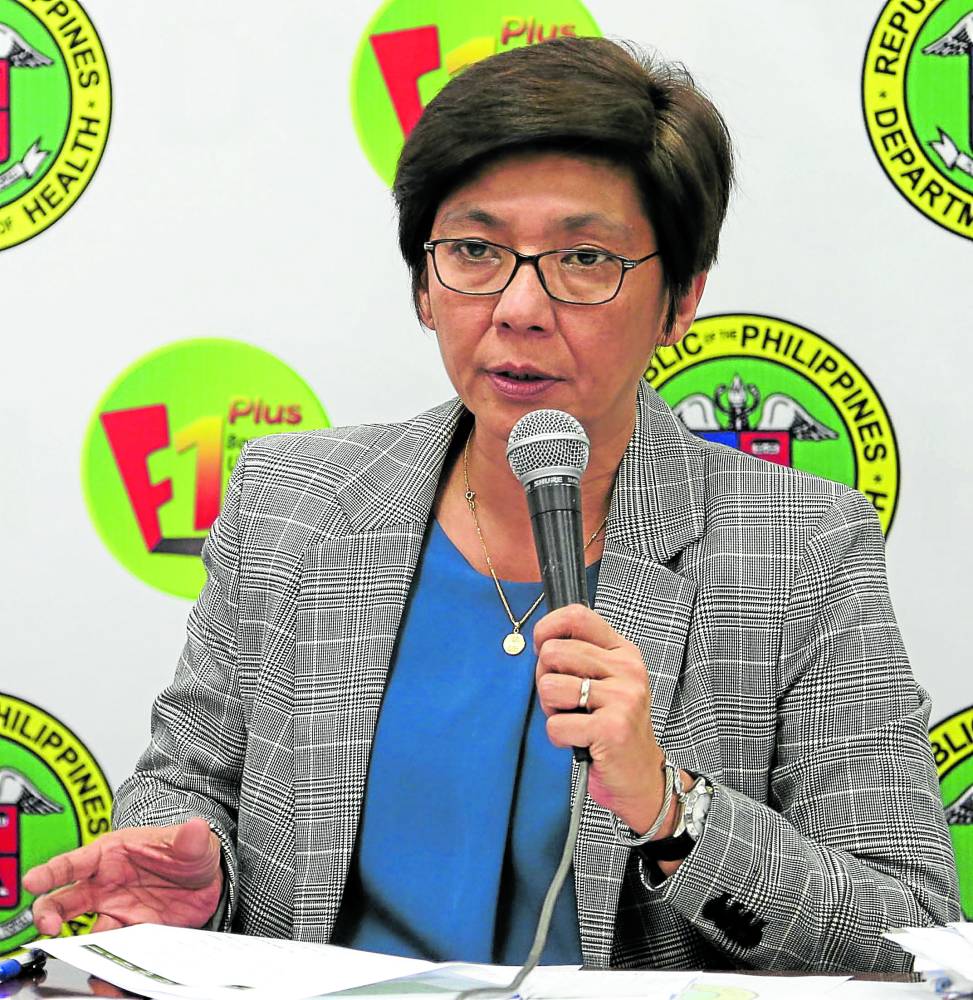No new covid cases in half of PH hospitals

Department of Health (DOH) Undersecretary Maria Rosario Vergeire. INQUIRER FILE PHOTO
About half, or 598 of the 1,232 health facilities and hospitals nationwide, have reported no new COVID-19 admissions from Dec. 5 to Dec. 9, the Department of Health (DOH) said.
“We have observed that nationally, 48.5 percent of hospitals reported no new COVID-19 admissions in the past five days,” said Health Undersecretary Maria Rosario Vergeire on Friday.
Having the highest number of health facilities with no new admission are Calabarzon with 92 and Central Luzon with 88.
DOH data also showed that 75.4 percent, or 49 out of 65 hospitals in Soccsksargen (South Cotabato, Cotabato, Sultan Kudarat, Sarangani and General Santos), had zero COVID-19 admissions during the period. This was followed by the Bangsamoro Autonomous Region in Muslim Mindanao (BARMM) at 73.1 percent, or 19 out of 26 hospitals, and Northern Mindanao at 65.7 percent, or 46 out of 70 hospitals.
In Metro Manila, 39.2 percent, or 62 out of 158 hospitals, also reported no new COVID-19 patients in the same period. “The national admissions have also been on a decline, albeit slowing down in recent weeks. It is currently at low-risk utilization at 20-percent capacity compared to July or prior to when cases started to peak,” said Vergeire, adding that intensive care unit (ICU) admissions had also been declining with current utilization rate of 25 percent of capacity.
Article continues after this advertisementAlso on Friday, Vergeire reported that the National Capital Region (NCR) was now under the “minimal risk” classification for COVID-19, with an average daily attack rate (Adar) of 0.87 per 100,000 individuals.
Article continues after this advertisementHealth authorities measure COVID-19 risk by determining the Adar, or the number of people found infected with the coronavirus per population of 100,000, over a two-week period.“All NCR areas are at minimal to low-risk case classification with negative two-week growth rates,” she said.
Quezon City, Makati, Parañaque, Manila, Valenzuela, Navotas, Marikina, Malabon, Muntinlupa, Caloocan and Pateros are under minimal risk.
The cities of San Juan, Las Piñas, Taguig, Pasay, Mandaluyong and Pasig, which showed a growth rate in the period covered, are classified low risk.
“The NCR’s recent cases are already six times lower than the July 2021 level, which was 628 cases per day; and almost three times lower than the January 2021 cases of 288 per day,” Vergeire said.
Data showed that the daily cases in NCR from Dec. 3 to Dec. 9 averaged only 106.
The DOH is monitoring Eastern Samar, Western Samar and Zamboanga Sibugay after these areas showed positive one-week and two-week growth rates. Eastern Samar is under moderate risk while Western Samar and Zamboanga Sibugay are under low risk classification.
Case update
On Friday, the DOH reported 379 new COVID-19 cases but this did not include data from four laboratories that did not operate on Dec. 8, a holiday, and five others that failed to submit data to the COVID-19 Document Repository System.
Active cases stood at 11,905, or 0.4 percent of the total of 2,836,200, nationwide. Of these, 4,860 were mild; 757, asymptomatic; 3,797, moderate; 2,060 severe; and 431 were in critical condition.
There were 631 people who recovered, bringing total recoveries to 2,774,334.
The death toll climbed to 49,961 with 25 new fatalities.
The DOH noted that of the 25 fatalities, five were recorded this month, while the rest were recorded between July and November this year. It noted that there was late encoding of death information to COVIDKaya.
“This issue is currently being coordinated with the epidemiology and surveillance units to ensure information is up to date,” the DOH said.
Citing the test results of 35,903 people last Wednesday, the DOH said the country’s COVID-19 positivity rate was at 1.3 percent, lower than the level reported on Thursday and still within the positivity target rate of the World Health Organization (WHO) below 5 percent.
Given these encouraging indicators, Vergeire said the COVID-19 pandemic might soon become endemic.
But she said there were many parameters to be considered first before the country could transition into endemicity.
Vergeire said the decline in cases, or zero new cases, should be sustained. There should also be a steady decline in the number of deaths or zero COVID-19-related deaths, she added.
“There should be no increase in the number of hospital admissions and there should be high vaccination coverage,” she said. “But (COVID-19 becoming endemic) is really possible in the future,” Vergeire said, adding that several countries had started preparing for transition into the endemic state of COVID-19.”
“We will also prepare for that,” she said.
6 found, 2 still missing
In the meantime, the DOH said six of the eight Filipinos who returned to the country from South Africa last month have already been located while two others have yet to be traced, Vergeire said at a virtual press briefing. These are the returning overseas Filipinos (ROFs) whose whereabouts were initially unknown. The remaining two are also ROFs, one is from northern Mindanao while the other is from Mimaropa. The eight were among the 253 travelers from South Arica who arrived in the country from Nov. 15 to Nov. 29, shortly before the government imposed a travel ban on South Africa following the WHO declaration of the Omicron as a variant of concern.
For more news about the novel coronavirus click here.
What you need to know about Coronavirus.
For more information on COVID-19, call the DOH Hotline: (02) 86517800 local 1149/1150.
The Inquirer Foundation supports our healthcare frontliners and is still accepting cash donations to be deposited at Banco de Oro (BDO) current account #007960018860 or donate through PayMaya using this link.